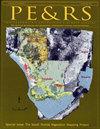地面激光雷达半自动化滚轮参数提取
IF 2
4区 地球科学
Q4 GEOGRAPHY, PHYSICAL
引用次数: 0
摘要
轧辊是热轧钢机组的重要组成部分。他们把铁水从轧机的一端运到另一端。钢材的质量在很大程度上取决于轧辊的表面质量。本文提出了从地面激光雷达点提取滚子参数的半自动方法。整个过程分为两步。首先,利用快速傅里叶变换图像匹配将三维点转换为二维图像,检测滚子的范围;每个滚筒的激光雷达点迭代拟合成一个圆。拟合圆的半径和圆心分别作为滚子的平均半径和平均旋转轴。这些参数也被人工提取,并与测量参数进行比较,以进行精度分析。所提出的方法能够在毫米级提取辊参数。用移动平均滤波器对识别错误的辊进行识别。第二步,利用过滤后的辊点确定辊参数。两个数据集被用来验证所提出的方法。在第一个数据集中,372个辊中有366个(97.3%)被识别并建模。第二个较小的数据集由18个被准确识别和建模的滚子组成。本文章由计算机程序翻译,如有差异,请以英文原文为准。
Semi-Automated Roller Parameters Extraction from Terrestrial Lidar
Rollers are an integral part of a hot-rolling steel mill. They transport hot metal from one end of the mill to another. The quality of the steel highly depends on the surface quality of the rollers. This paper presents semi-automated methodologies to extract roller parameters from terrestrial
lidar points. The procedure was divided into two steps. First, the three-dimensional points were converted to a two-dimensional image to detect the extents of the rollers using fast Fourier transform image matching. Lidar points for every roller were iteratively fitted to a circle. The radius
and center of the fitted circle were considered as the average radius and average rotation axis of the roller, respectively. These parameters were also extracted manually and were compared to the measured parameters for accuracy analysis. The proposed methodology was able to extract roller
parameters at millimeter level. Erroneously identified rollers were identified by moving average filters. In the second step, roller parameters were determined using the filtered roller points. Two data sets were used to validate the proposed methodologies. In the first data set, 366 out of
372 rollers (97.3%) were identified and modeled. The second, smaller data set consisted of 18 rollers which were identified and modelled accurately.
求助全文
通过发布文献求助,成功后即可免费获取论文全文。
去求助
来源期刊

Photogrammetric Engineering and Remote Sensing
地学-成像科学与照相技术
CiteScore
1.70
自引率
15.40%
发文量
89
审稿时长
9 months
期刊介绍:
Photogrammetric Engineering & Remote Sensing commonly referred to as PE&RS, is the official journal of imaging and geospatial information science and technology. Included in the journal on a regular basis are highlight articles such as the popular columns “Grids & Datums” and “Mapping Matters” and peer reviewed technical papers.
We publish thousands of documents, reports, codes, and informational articles in and about the industries relating to Geospatial Sciences, Remote Sensing, Photogrammetry and other imaging sciences.
 求助内容:
求助内容: 应助结果提醒方式:
应助结果提醒方式:


